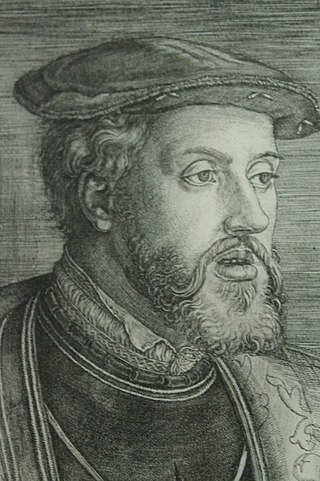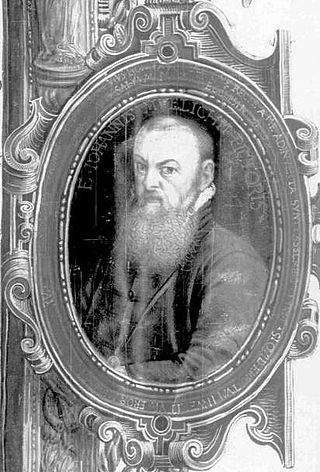
Ludwig Refinger (sometimes Reffinger, born c. 1515, died in Munich 1549) was a German Northern Renaissance painter. [1] [2]

Ludwig Refinger (sometimes Reffinger, born c. 1515, died in Munich 1549) was a German Northern Renaissance painter. [1] [2]
Refinger began his career as an apprentice to Wolfgang Mielich, and then started working with Barthel Beham. He received commissions by the Duke of Bavaria, William IV in 1537 and 1540. He contributed three pictures to a history cycle commissioned by the Duke. After Beham's death in 1540, he married his widow. In 1542 he again received a ducal commission, this time by Louis X to paint ceilings and design stained glass windows for the Landshut Residence. [1]
His paintings show similarities to those of Barthel Beham and Hans Schöpfer the Elder, as well as influences from Italian art from the beginning of the 16th century. [1]

Federico II of Gonzaga was the ruler of the Italian city of Mantua from 1519 until his death. He was also Marquis of Montferrat from 1536.

In art history, "Old Master" refers to any painter of skill who worked in Europe before about 1800, or a painting by such an artist. An "old master print" is an original print made by an artist in the same period. The term "old master drawing" is used in the same way.

Heinrich Aldegrever or Aldegraf was a German painter and engraver. He was one of the "Little Masters", the group of German artists making small old master prints in the generation after Albrecht Dürer.

Giovanni Girolamo Savoldo, also called Girolamo da Brescia, was an Italian High Renaissance painter active mostly in Venice, although he also worked in other cities in northern Italy. He is noted for his subtle use of color and chiaroscuro, and for the sober realism of his works, which are mostly religious subjects, with a few portraits. His portraits are given interest by their accessories or settings; "some even look like extracts from larger narratives".

Georg Pencz was a German engraver, painter and printmaker.

Sebald Beham (1500–1550) was a German painter and printmaker, mainly known for his very small engravings. Born in Nuremberg, he spent the later part of his career in Frankfurt. He was one of the most important of the "Little Masters", the group of German artists making prints in the generation after Dürer.

Barthel Beham (1502–1540) was a German engraver, miniaturist, and painter.

Roman Charity or Cimon and Pero is an ancient Greek and Roman exemplary story of filial piety in which a woman secretly breastfeeds her father or mother, incarcerated and supposedly sentenced to death by starvation. Once caught, the loving devotion shown so moves the authorities that she is forgiven and the parent is typically freed. The father in the story is often named Cimon and the daughter Pero, although other versions name the father Mycon. First attested in surviving Roman sources, it became a common theme in Early Modern period of Western European art, particularly the Baroque period.

Joos van Cleve was a leading painter active in Antwerp from his arrival there around 1511 until his death in 1540 or 1541. Within Dutch and Flemish Renaissance painting, he combines the traditional techniques of Early Netherlandish painting with influences of more contemporary Renaissance painting styles.

Events from the year 1540 in art.
Events from the year 1502 in art.
Christ and the Sheep Shed is a polemical woodcut made in 1524 by the Nuremberg artist Barthel Beham, one of the Little Masters. Created in the early part of the Protestant Reformation, this woodcut illustrates the beliefs of the artist, as well as other reformers, about the manipulation of the Catholic hierarchy. His work was influenced by reformers, such as Martin Luther, as well as other artists like Barthel's older brother, Sebald. This woodcut was created during the height of the peasant revolts and, though they were less severe in Nuremberg than in other parts of Germany, the social implications were greatly felt. Though there is little information on this particular woodcut, it represents much of the political and social aspects of the Reformation, and interpretation provides insight on the artist's perspective of the era. The distribution of woodcuts was one of the most effective modes of propaganda during the Protestant Reformation. Christ and the Sheep Shed depicts the radical sentiment of the period in which it was created, and portrays the wide-ranging effects of the Reformation and religion on all aspects of German culture. The image is unrealistic as an authentic situation. However, it was used as a symbolic interpretation of the Catholic Church’s manipulation over people and their faith.

The account of the beheading of Holofernes by Judith is given in the deuterocanonical Book of Judith, and is the subject of many paintings and sculptures from the Renaissance and Baroque periods. In the story, Judith, a beautiful widow, is able to enter the tent of Holofernes because of his desire for her. Holofernes was an Assyrian general who was about to destroy Judith's home, the city of Bethulia. Overcome with drink, he passes out and is decapitated by Judith; his head is taken away in a basket.

The Little Masters, were a group of German printmakers who worked in the first half of the 16th century, primarily in engraving. They specialized in very small finely detailed prints, some no larger than a postage stamp. The leading members were Hans Sebald Beham, his brother Barthel, and George Pencz, all from Nuremberg, and Heinrich Aldegrever and Albrecht Altdorfer. Many of the Little Masters' subjects were mythological or Old Testament stories, often treated erotically, or genre scenes of peasant life. The size and subject matter of the prints shows that they were designed for a market of collectors who would keep them in albums, of which a number have survived.
Barthel may refer to:

Hanns Lautensack was a German etcher and draughtsman.

Bartholomäus Bruyn (1493–1555), usually called Barthel Bruyn or Barthel Bruyn the Elder, was a German Renaissance painter active in Cologne. He painted altarpieces and portraits, and was Cologne's foremost portrait painter of his day.

Hans Muelich or Mielich, was a German painter and woodcutter.

Hercules Fighting the Nemean Lion is a work of 1634 by the Spanish painter Francisco de Zurbarán. It is conserved in the Museo del Prado.

Erhard Schön was a German woodcut designer and painter.
{{cite book}}: |first= has generic name (help)